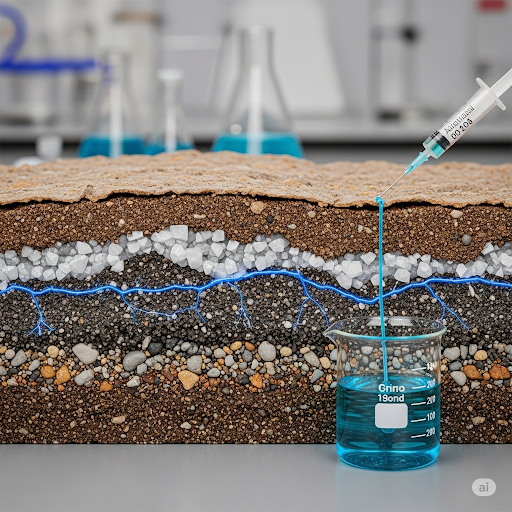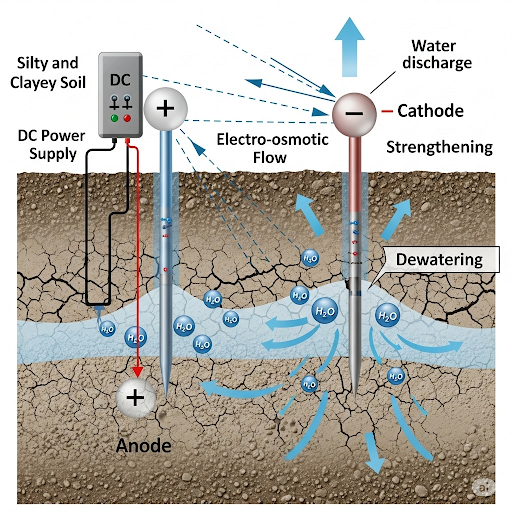Types of Soil Stabilization Techniques
Enroll to start learning
You’ve not yet enrolled in this course. Please enroll for free to listen to audio lessons, classroom podcasts and take practice test.
Interactive Audio Lesson
Listen to a student-teacher conversation explaining the topic in a relatable way.
Mechanical Stabilization
🔒 Unlock Audio Lesson
Sign up and enroll to listen to this audio lesson

Today, we're going to explore mechanical stabilization. It involves blending different soil types or adding granular materials to improve properties like gradation and compaction. Can anyone tell me what tools are typically used for this?

I think things like compactors and rollers are used?

Exactly! Compactors, rollers, and graders are essential tools in mechanical stabilization. They help prepare embankments and subgrade layers. Why do you think compaction is important in this process?

I imagine it makes the soil more stable and better for building on?

Correct! Compaction increases the density of the soil, which enhances its load-bearing capacity. Think about it like packing a suitcase; the more efficiently we pack, the more we can fit!

Does this apply to all soil types?

Good question! While mechanical stabilization works well for many soils, it’s particularly effective for granular soils. Let’s summarize: Mechanical stabilization improves soil through blending and mechanical tools for better gradation and compaction.
Chemical Stabilization Techniques
🔒 Unlock Audio Lesson
Sign up and enroll to listen to this audio lesson

Now, let's dive into chemical stabilization. This process involves adding chemical agents to soil to improve its properties. Who remembers some common additives?

Lime and cement, right?

Yes! Lime is particularly effective for clayey soils. It reduces swelling and improves the plasticity index. What happens when lime reacts with clay?

It forms cementitious compounds?

Exactly! These compounds enhance strength. Cement stabilization, on the other hand, adds compressive strength and is suited for sandy and gravelly soils. Does anyone know another chemical stabilizer?

Fly ash is another one!

Right! Fly ash is a by-product that enhances soil properties through a pozzolanic reaction when mixed with water and lime. Remember, chemical additives can significantly improve the long-term performance of soils.
Thermal and Electrical Stabilization
🔒 Unlock Audio Lesson
Sign up and enroll to listen to this audio lesson

Let’s briefly discuss the thermal and electrical stabilization methods. Thermal stabilization involves heating or freezing the soil. Why do you think this method is rarely used in highway construction?

Maybe because it’s too expensive?

Exactly! The high costs usually keep it from being practical. Now, can anyone explain electrical stabilization?

Is that the one with electro-osmosis?

Correct! It helps in dewatering and stabilizing silty and clayey soils. It’s effective but very specialized! So, we covered mechanical, chemical, thermal, and electrical stabilization techniques today.
Introduction & Overview
Read summaries of the section's main ideas at different levels of detail.
Quick Overview
Standard
The section details multiple soil stabilization techniques, including mechanical stabilization, which enhances soil gradation and compaction, and chemical stabilization using additives like lime and cement. Thermal and electrical stabilization methods are briefly introduced, illustrating their limited applications.
Detailed
Types of Soil Stabilization Techniques
Soil stabilization is critical in ensuring the strength and durability of roadway foundations. This section outlines several methods of soil stabilization, detailing the following techniques:
5.2.1 Mechanical Stabilization
This method involves blending various soil types or adding materials to enhance their properties. It uses tools like compactors and graders to improve gradation and compaction. Common applications include embankments and subgrade preparation.
5.2.2 Chemical Stabilization
Chemical stabilization improves soil properties through the reaction of additives:
- Lime Stabilization: Particularly effective for clayey soils, lime enhances plasticity and forms cementitious compounds.
- Cement Stabilization: This technique raises compressive strength and is suitable for sandy and gravelly soils.
- Fly Ash Stabilization: As a by-product of power plants, fly ash reacts with lime and water, improving strength over time.
- Bituminous Stabilization: Used primarily for waterproofing soils and reducing moisture sensitivity in granular soils.
5.2.3 Thermal Stabilization
This less common method involves altering soil properties through heating or freezing processes, noted for its high cost and rare application in highways.

5.2.4 Electrical Stabilization
This technique utilizes electro-osmosis for silty and clayey soils, effectively aiding in dewatering and strengthening the material.
Understanding these techniques is essential for engineers in selecting appropriate stabilization methods based on specific soil conditions and project requirements.
Youtube Videos










Audio Book
Dive deep into the subject with an immersive audiobook experience.
Mechanical Stabilization
Chapter 1 of 4
🔒 Unlock Audio Chapter
Sign up and enroll to access the full audio experience
Chapter Content
Involves blending different soil types or adding granular materials to improve gradation and compaction characteristics.
- Tools Used: Compactors, rollers, graders.
- Applications: Embankments, subgrade preparation.
Detailed Explanation
Mechanical stabilization is a technique that enhances the physical properties of soil. It involves combining different types of soil or adding granular materials to achieve better gradation—essentially ensuring that the soil is compacted and well-graded for strength. Tools like compactors, rollers, and graders are utilized to achieve the desired density. This technique is commonly used in the preparation of embankments and subgrades, ensuring a solid foundation for roads and other structures.
Examples & Analogies
Imagine a chef mixing different types of flour to create the perfect dough for bread. Just like how different flours can improve the texture or rise of the bread, blending various soils improves their performance and strength. When constructing a road, mixing soils is like 'baking' a better foundation.
Chemical Stabilization
Chapter 2 of 4
🔒 Unlock Audio Chapter
Sign up and enroll to access the full audio experience
Chapter Content
Involves mixing chemical additives that react with soil particles to improve binding and reduce plasticity.
a) Lime Stabilization
- Used for clayey soils.
- Improves plasticity index and reduces swelling.
- Forms cementitious compounds (calcium silicate hydrates).
b) Cement Stabilization
- Adds compressive strength.
- Suitable for sandy and gravelly soils.
- Reactions: hydration of cement and pozzolanic reaction.
c) Fly Ash Stabilization
- By-product of thermal power plants.
- Pozzolanic in nature; reacts with lime and water.
- Improves strength over time.
d) Bituminous Stabilization
- Used to waterproof soil.
- Reduces moisture sensitivity.
- Suitable for granular soils.
Detailed Explanation
Chemical stabilization refers to the addition of chemical agents to soil to improve its properties. Here are the main sub-techniques:
- Lime Stabilization: This is particularly effective for clayey soils. Lime reduces plasticity and swelling, as it reacts with soil particles to form compounds that give the soil more strength.
- Cement Stabilization: Cement is added to improve compressive strength. It works well with sandy and gravelly soils, where it reacts through hydration and pozzolanic reactions to enhance strength.
- Fly Ash Stabilization: A by-product from power plants, fly ash reacts with lime and moisture to improve soil properties over time. It’s a cost-effective way to build strength in certain soil types.
- Bituminous Stabilization: This method involves treating soils with bitumen to make them waterproof and reduce moisture sensitivity, making it more suitable for use in areas with high water exposure.
Examples & Analogies
Think of chemical stabilization like adding ingredients to a smoothie. Just as you might add yogurt or honey to improve the taste, chemical additives like lime or cement enhance the properties of soil, ensuring it’s strong and suitable for construction. For instance, adding lime to clay soil is similar to adding yogurt to make your smoothie creamier and more enjoyable!
Thermal Stabilization
Chapter 3 of 4
🔒 Unlock Audio Chapter
Sign up and enroll to access the full audio experience
Chapter Content
Involves heating or freezing soil to change its properties.
- Rarely used in highway construction due to high cost.
Detailed Explanation
Thermal stabilization is a method that changes the properties of soil through the application of temperature—either by heating or freezing. This technique can alter the soil's physical and mechanical properties, making it more stable. However, this method is rarely utilized in highway construction due to its high implementation costs, which generally outweigh the benefits compared to other stabilization techniques.
Examples & Analogies
Imagine trying to change the texture of butter by either warming it up or placing it in the freezer. Just as heat can soften butter while cold can make it firmer, thermal stabilization changes soil properties through temperature manipulation, though it’s not often practical due to cost, much like how it might not be worth it to heat butter just to spread it easier on toast.
Electrical Stabilization
Chapter 4 of 4
🔒 Unlock Audio Chapter
Sign up and enroll to access the full audio experience
Chapter Content
Electro-osmosis technique for silty and clayey soils.
- Effective in dewatering and strengthening soils.
Detailed Explanation
Electrical stabilization uses an electro-osmosis technique to improve the properties of silty and clayey soils. By applying an electric current through the soil, water molecules are moved, which helps in dewatering the soil. This process increases the soil's strength and stability, making it more suitable for construction. It’s especially beneficial in areas where high moisture content is a problem.
Examples & Analogies
Consider how a sponge absorbs water when you dip it into a bowl of water. Just as you can squeeze the sponge to remove water, using electricity on soil can help 'squeeze' out excess moisture, making the ground more solid and ready for building just as you'd want dry bread crumbs instead of mushy, wet ones when making a stuffing!
Key Concepts
-
Mechanical Stabilization: A method that involves blending soil types to enhance properties.
-
Chemical Stabilization: The use of additives like lime and cement to improve soil characteristics.
-
Thermal Stabilization: A rare method of altering soil properties through heating or freezing.
-
Electrical Stabilization: A technique using electro-osmosis to strengthen specific soil types.
Examples & Applications
Mechanical stabilization can be used to prepare a stable subgrade for road construction by utilizing compactors.
Lime stabilization is often employed to reduce swelling in clayey soils, making them suitable for building foundations.
Memory Aids
Interactive tools to help you remember key concepts
Rhymes
Mechanical tools, like rollers and scoops, compact the soil in neat little loops.
Stories
Imagine a castle builder who mixes sand and clay in different amounts to make the strongest foundation. They choose their ingredients carefully, just like engineers do when stabilizing soil.
Memory Tools
The 'LEAF B' used in soil stabilization can help remember Lime, Electrical, Ash, Fly, and Bituminous.
Acronyms
MCT for Mechanical, Chemical, Thermal stabilization types.
Flash Cards
Glossary
- Soil Stabilization
A process to improve soil properties for construction purposes.
- Mechanical Stabilization
Enhancing soil characteristics through blending and compaction using heavy machinery.
- Chemical Stabilization
Involves adding chemical agents to soil to improve binding and reduce plasticity.
- Lime Stabilization
Using lime to improve the properties of clay soils.
- Cement Stabilization
The addition of cement to soil to enhance its strength.
- Fly Ash Stabilization
Utilizing fly ash as a soil additive to improve strength and performance.
- Thermal Stabilization
Changing soil properties through heating or freezing.
- Electrical Stabilization
Using electro-osmosis to dewater and strengthen silty and clayey soils.
Reference links
Supplementary resources to enhance your learning experience.
